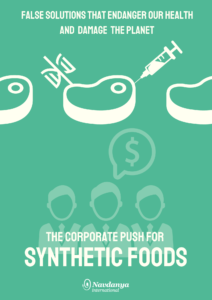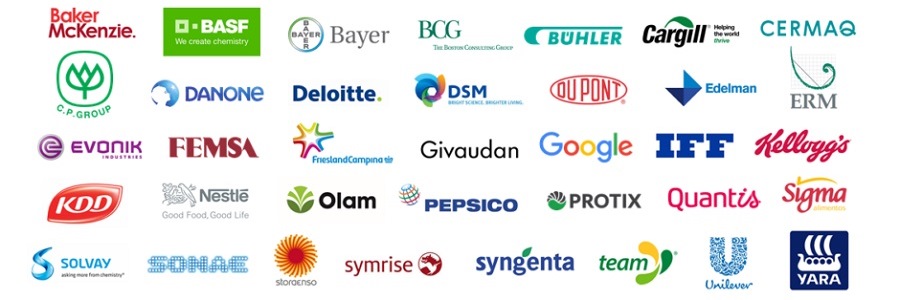The Corporate Push for Synthetic Foods: False Solutions That Endanger Our Health and Damage the Planet
FEATURED RESEARCH PAPER, 4 Jul 2022
Navdanya International– TRANSCEND Media Service
Artificial Food Is Detrimental to Ecological Transition
Foreword by Dr Vandana Shiva, President of Navdanya International
22 Jun 2022 – How can we heal our relationship with food in the age of artificial food? In response to the crises in our food system we are witnessing the rise of technological solutions that aim to replace animal products and other food staples with lab-grown alternatives.
Artificial food advocates are reiterating the old and failed rhetoric that industrial agriculture is essential to feed the world. Real, nutrient-rich food is gradually disappearing, while the dominant industrial agricultural model is causing an increase in chronic diseases and exacerbating climate change.
The notion that high-tech, “farm free” lab food is a viable solution to the food crisis is simply a continuation of the same mechanistic mindset which has brought us to where we are today – the idea that we are separate from and outside of nature.
Industrial food systems have reduced food to a commodity, to “stuff” that can then be constituted in the lab. In the process both the planet’s health and our health has been nearly destroyed.
Industrial agriculture is re-inventing its future based on “fake farming” with “fake food”, with chemicals and GMOs, surveillance drones and spyware. Farming without farmers, farming without biodiversity, farming without soil, is the vision of those who have already brought us to the brink of catastrophe.
This is why artificial meat, invested in by the giant tycoons of factory farming, are not viable alternatives. They are just additional sources of profit for the same players and take political power away from regenerative farmers and local communities.
These modes deny the essential symbiotic relationships between humans, plants, animals and microorganisms and, in turn, deny their potential to maintain and regenerate the web of life. Food is the web of life and we cannot separate food from life. Similarly, we cannot separate ourselves from the Earth.
Solutions to our global crises already exist and they come from building cultures of interconnection and regeneration, as well as healing our relationships with food, nature and community. We need to become aware of the connections that hold the opportunity to regenerate the earth, our health, our food economies and food cultures through a real agriculture that cares for the earth and for people. Real food is not created in a laboratory, but comes from biodiverse farms that take care of the land by embracing a regenerative agriculture model.
We must therefore work actively to renew and regenerate the Planet by participating in ecological processes of reciprocity and restoring biodiversity. For this to happen, the act of eating must once again become an ecological act, so that the false solutions proposed by the advocates of artificial food, which do nothing to counter the profit-driven agri-food industry, do not create further crises.
The corporate push for synthetic foods
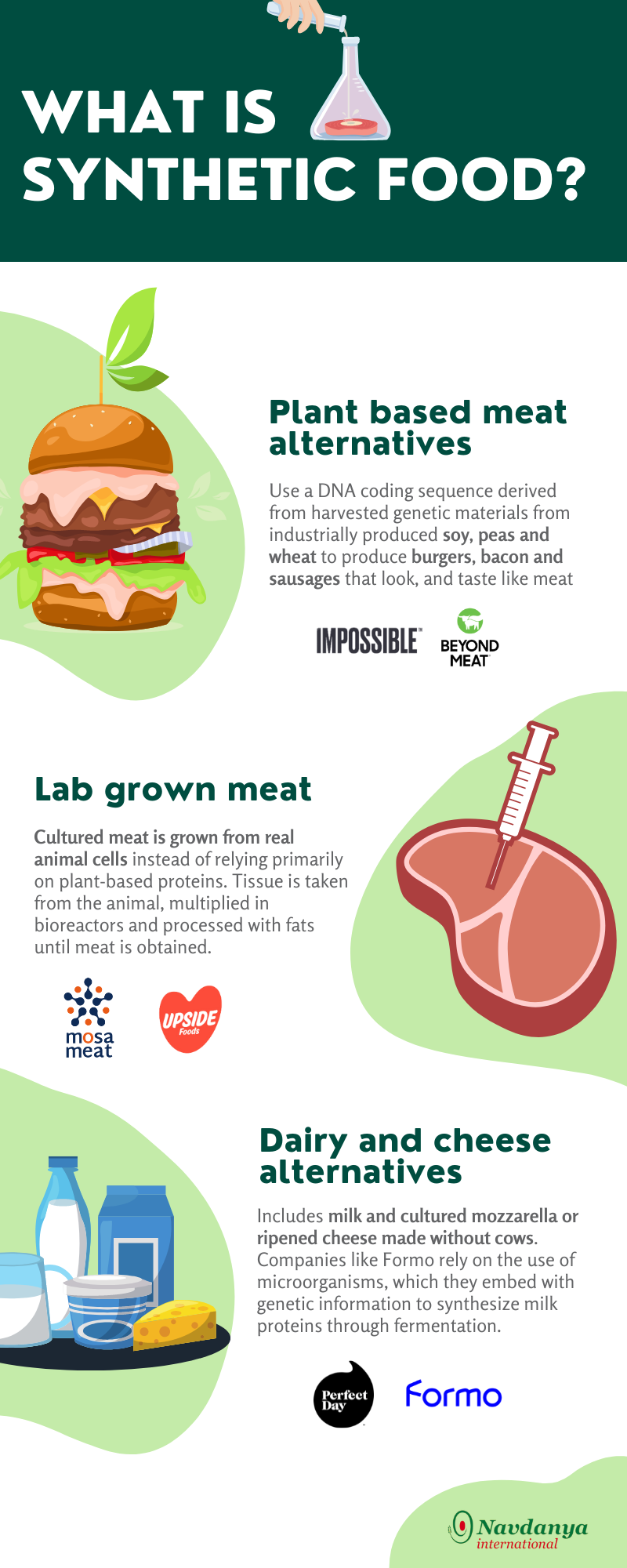 Fully artificial food is an increasingly popular trend focused on developing a new line of synthetically produced, ultra-processed food products by using recent advances in synthetic biology, artificial intelligence, and biotechnology. These new products seek to imitate and replace animal products, food additives, and expensive, rare, or socially conflictive ingredients (such as palm oil). Biotech companies and agribusiness giants are seeing the opportunity to move into this promising market of “green” consumption and hence these products are marketed to a new generation of environmentally conscious consumers who are growing critical of the grim realities of industrial food production. As a result, meatless burgers and sausages, as well as imitations of cheese, dairy products, seafood, and others, have begun to flood the market, being found anywhere from fast food chains to local grocery stores.
Fully artificial food is an increasingly popular trend focused on developing a new line of synthetically produced, ultra-processed food products by using recent advances in synthetic biology, artificial intelligence, and biotechnology. These new products seek to imitate and replace animal products, food additives, and expensive, rare, or socially conflictive ingredients (such as palm oil). Biotech companies and agribusiness giants are seeing the opportunity to move into this promising market of “green” consumption and hence these products are marketed to a new generation of environmentally conscious consumers who are growing critical of the grim realities of industrial food production. As a result, meatless burgers and sausages, as well as imitations of cheese, dairy products, seafood, and others, have begun to flood the market, being found anywhere from fast food chains to local grocery stores.
Although these products market themselves as ‘eco-friendly’, ‘healthy’, and ‘sustainable’, they are no such thing as they do little to truly address the root problems of industrial agriculture and its environmental, and health consequences. Consequences that can be largely blamed on the same circle of businessmen who today finance the development of this biotech industry. These products instead represent the next generation of ultra-processed junk foods that work to further entrench industrial agriculture models due to their direct dependence on globalized commodity chains, agrochemicals, GMOs, monocultures, and even conventional animal production. In other words, synthetic foods are quickly becoming a next means to consolidate even more power and profit into the hands of a few food giants without facing the implications of ecological devastation, worsening human health, and exacerbated climate change.
One of the key differences between conventional junk food products and these new synthetic foods is the use of new technological innovations such as synthetic biology and genetic engineering. Synthetic biology is a new type of biotechnology which is now creating entirely new organisms and microorganisms through the genetic modification or engineering of an organism’s internal genetic parts to reconfigure them in new ways. By implanting pieces of other organisms’ DNA into microorganisms, or reconfiguring internal genetic information, these new technologies trigger microorganisms, cells, or other forms of genetic material to ‘ferment’ and reproduce in order to trigger them to create new, completely synthetic ingredients. The use of the word ‘fermentation’ in synthetic biology hence creates a false analogy between traditional forms of natural microbial fermentation and these new, completely artificial biotechnologies.
These new technologies are now being used by companies such as Beyond Meat, Motif Foodworks, Ginkgo Bioworks (custom-built microbes), BioMilq (lab-grown breast milk), Nature’s Fynd (fungi-grown meat and dairy alternatives), Eat Just (egg substitutes made from plant proteins), Perfect Day Food (lab-grown dairy products) or NotCo.
Companies such as Beyond Meat and Impossible Foods use a DNA coding sequence derived from soybeans or peas to create a product that looks and tastes like real meat. Imitations of cheese and dairy products are also starting to pop up. For instance, companies like Formo are using synthetic biology to synthesise milk proteins through fermentation for mozzarella and ricotta cheeses without cows.
Filler ingredients for these products also still rely heavily on the extensive processing of conventionally cultivated and mostly GMO crops. For instance, the Impossible Burger is made almost entirely from industrially produced wheat, maize, soya, coconut and potato, in addition to additional bioengineered ingredients. Proteins, carbohydrates from these conventional crops are chemically extracted, cooked and then extruded through machines that blend and shape them into strands resembling short muscle fibers, allowing manufacturers to convincingly imitate a range of processed meat products[1].
Cell-Cultured Synthetic Meat and Dairy
Lab-grown or cultured meat and dairy products are now also being marketed as yet another alternative to animal products, with many companies investing in cell-culturing or ‘fermentation’ of foods made from real animal cells. In the case of cell-based meat, tissue is taken from a living cow and combined with extracted stem cells to grow into muscle fibers in the lab. Once enough (over 20,000) have been obtained from this process they are colored, minced, mixed with fats, and shaped into burgers.
For instance, Upside Foods (previously known as Memphis Meats) produces meat through this method, by using self-reproducing animal cells. The rationale is that such an approach would eliminate the need to breed and slaughter a huge amount of animals, thus ironing out many ethical and ecological concerns along the supply chain. While lab-grown meat is not yet available to the public, companies like Upside Foods are heavily investing in research and development in order to make their products economically affordable over the long term to compete with commercial meat options. The Canadian company Better Milk, for instance, is also investing heavily in the production of cow’s milk using bovine mammary cells.
Yet, whether upscaling lab-grown food will one day be economically viable remains very doubtful. An article from the Counter reflects on the limits of the transformative potential of this emerging technology, with particular attention to the many obstacles faced by cultured meat companies. Through a rigorous review of scientific data, the article demonstrates that cultivated meat gives rise to a lot of inefficiencies and limitations in scalability, embodied by the need for intensive and sophisticated machinery, structural limitations on cell metabolisms and immunity to foreign contaminants, and a series of complex processes that all place a strict limit on the expansion of production. These factors contribute to a lack of cost competitiveness in comparison with the conventional meat products they wish to replace, as cultured meat production would amount to far less than conventional slaughterhouses. Especially when cell-culturing facilities at the scale needed have previously never been made viable.
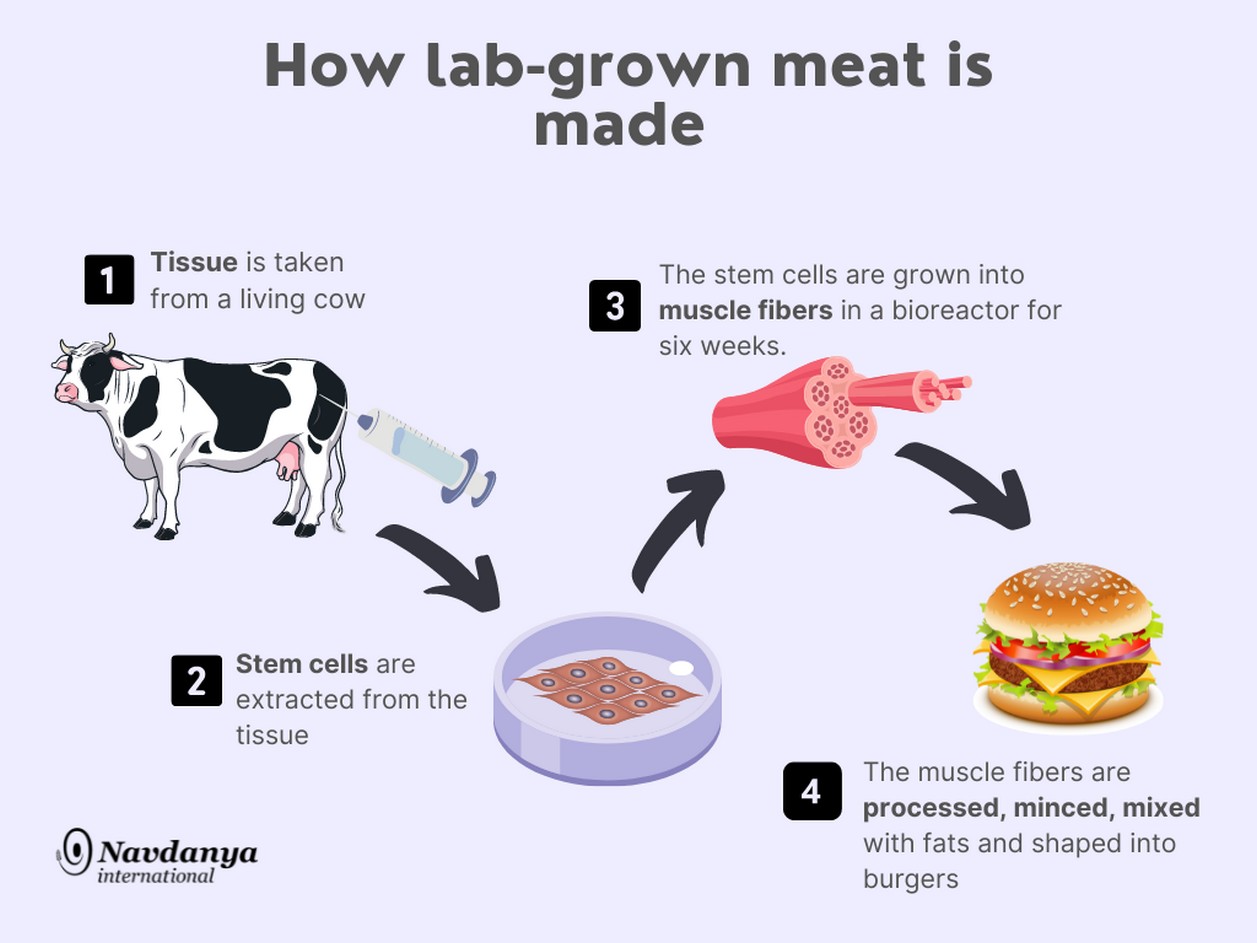
Who is behind the surge of fake food and who benefits?
Over the last couple of years, and following the relentless emergence of new startups, the market for synthetic and plant-based alternatives has been rapidly expanding, with financial backing skyrocketing in 2020. The Good Food Institute, a lobby advocate group for the adoption of animal product alternatives, reports that in the United States, the plant-based market has already grown from 4.9 billion in 2018 to 7 billion in 2020, which represents an overall increase of 43% in dollar sales over the last two years. Similarly, the plant-based meat market is also booming, having reached a value of 1.4 billion and registered a growth of 72% by 2020. Beyond Meat has been one of the “hottest” stocks in 2019. The plant-based meat company’s shares grew a whooping 859% during its first three months.
The synthetic biology industry is also right behind. It has reached a value of $12 billion in the last decade and is expected to double by 2025, and to reach $85 billion in 2030. Companies specializing in this field have also grown six-fold in the last ten years.
Clearly it is agribusiness that stands to profit from this lucrative and quickly expanding market. Therefore, It should not come as a surprise that a lot of meat industry giants like Tyson foods, JBS, Cargill, Nestlé, and Maple Leaf Foods are investing in this blossoming market. Moreover, high profile big tech investors such as Microsoft founder Bill Gates and Amazon founder Jeff Bezos have also joined in by providing substantial financial backup to startups and biotechnology companies pursuing innovations in the sector. In fact, Bill Gates alone has already invested 50 million dollars in Impossible Foods and actively finances Beyond Meat, Ginkgo Bioworks, BioMilq, Motif Foodworks, C16 Biosciences, and Memphis Meats (now Upside Foods) through his Breakthrough Energy Ventures investment fund.
Other prominent start-ups funded by this billionaire investment include- Eat Just (egg substitutes made from plant proteins), Perfect Day Food (lab-grown dairy products), and NotCo (plant-based animal products made through AI), to name a few.
Given the widespread success of the plant-based industry, it is not surprising that big plant-breeding companies like Bayer also see a great opportunity for investment and expansion in this market. As put by Bob Reiter, Bayer’s head of research and development at the company’s crop science division, in reference to plant based-meat companies: “They are sourcing different types of crops and that could also create opportunity for us, being a company that is a plant-breeding company”.
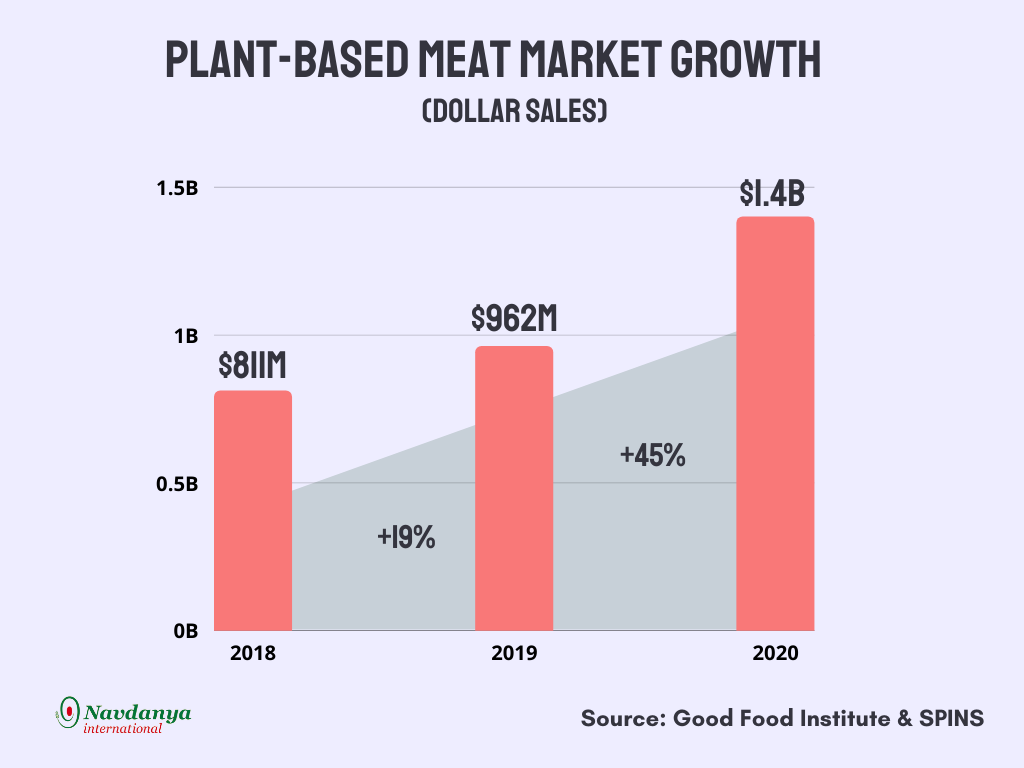
An ecological choice or a wolf in sheep’s clothing?
Many studies are questioning the alleged sustainability of this industry, which now comprises a constellation of new ‘green-conscious’ start-ups. It is not surprising that the tremendous rise of synthetic foods is happening at a time when ethical concerns linked to the meat and dairy industry are increasingly under the spotlight. As the industrial agrifood industry is threatened by consumer apathy, big companies that stand to lose significant profits are trying to tap into a new market of environmentally aware consumers looking for alternatives. Hence, the promotion of these synthetic foods is nothing more than a clever way to reorient profits back to the same old companies by re-purposing the destructive technologies of the Green Revolution combined with new biotechnologies as a well-disguised ‘sustainable alternative’.
This reinforcement of the industrial agriculture production model becomes evident when one looks at the ingredients that make up these synthetic foods. Primarily made up of conventionally grown peas, potatoes, soya, coconut, and maize, these products rely on heavy processing, monocultures, agrochemicals, GMOs, deforestation and a contaminating global-supply chain.
Yet, companies remain adamant in their claims that their plant-based meats require less water, less land, and produce less greenhouse gases than their counterparts, as well as simultaneously ironing out animal welfare concerns. In so doing, they deliberately sidestep the impacts of the toxic industrial supply chain their products depend on.
In addition, lab-grown counterparts also require massive bioreactors, and the use of sterile single-use plastic equipment. To come close to matching current meat consumption, for example, production facilities would need to number in the tens of millions, increasing problematic plastic consumption and increasing energy requirements, all while still relying on globalized industrial agriculture models and supply chains.
Most significantly, to run, these bioreactors require large amounts of nutrients for cells to grow and reproduce. Given the limited production of individual amino acid formulations suited for cell culture globally, one hope is to use soy to derive the full amino acid profile necessary for cell growth. This would work to only further entrench the already destructive cultivation of soy.
Gruesomely and ironically, other parts of the nutrient broth used to culture cells also directly derive from current industrial animal production, as some of them are made using fetal cow’s blood obtained from conventionally slaughtered pregnant cows. Stem cells necessary for cell reproduction during the cell culturing process also come from fetal cows. Without the mass abundance of slaughtered fetal cows, can cell-cultured meat scale up? And so, can lab-grown meat be considered to solve the problem of animal welfare and environmental degradation if it is completely dependent on ingredients that derive from industrial beef production? This gruesome reality says otherwise.
Meat analogs and cell-based meats are also much more carbon intensive than we are led to believe. A recent study has shown that the fossil fuel energy required for the production of lab meat is not sustainable and could by far surpass the output of livestock like pigs and poultry.
Vast amounts of energy are required for the production of synthetic foods. These include several energy intensive steps such as the operation of the bioreactors, temperature controls, aeration, and mixing processes. Thus, on the basis of these indicators, the sector is in no position to claim that synthetic meat production is inherently more sustainable than traditional production systems. Studies like these further point to how upscaling synthetic meat production is not the way towards a carbon free society, especially when we consider the scaling needed to match current consumption levels of the products this industry is trying to replace.
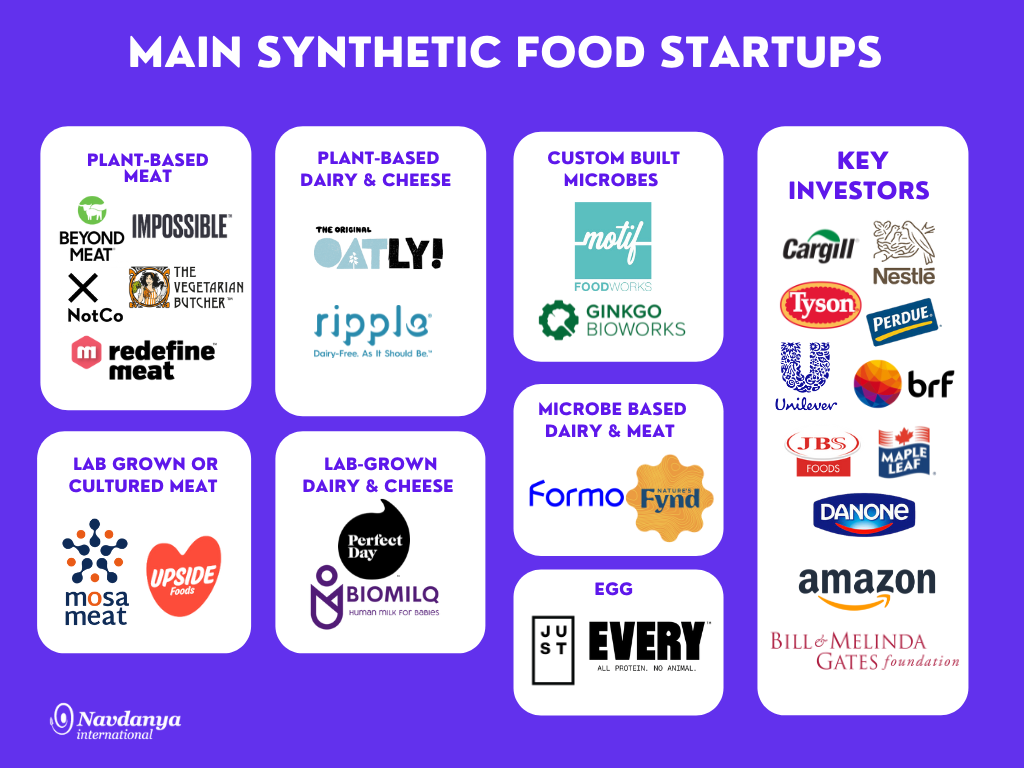
Are plant-based foods healthier? Not if they are ultra-processed
It is now widely known how industrial processing can make food less nutritious and thus harmful to human health, and according to a recent report, the latest generation of junk synthetic foods is no exception. In order to make their products, chemically extracted protein isolates from commodity crops such as soy, peas and potatoes are used and mixed in with added flavorings, food additives, and now, perhaps most dangerously, genetically engineered artificial ingredients to try to approximate the taste and texture of real animal products. As a result, these ultra-processed foods typically contain high levels of sodium, fats and artificial food enhancers in order to be palatable, placing them under the same categories as junk foods.
Moreover, ultra processed foods are made from refined ingredients which means that they lack many of the nutrients found in traditional animal products such as zinc, iron and vitamin B-12. These nutrients and fortifiers thus need to be added as separate ingredients in synthetic meat, but cannot be absorbed as effectively as they would from whole foods, and can cause harmful interference with other nutrients. As a result our bodies may derive less health benefits from them and therefore they should not be part of a nutritious and environmentally friendly diet.
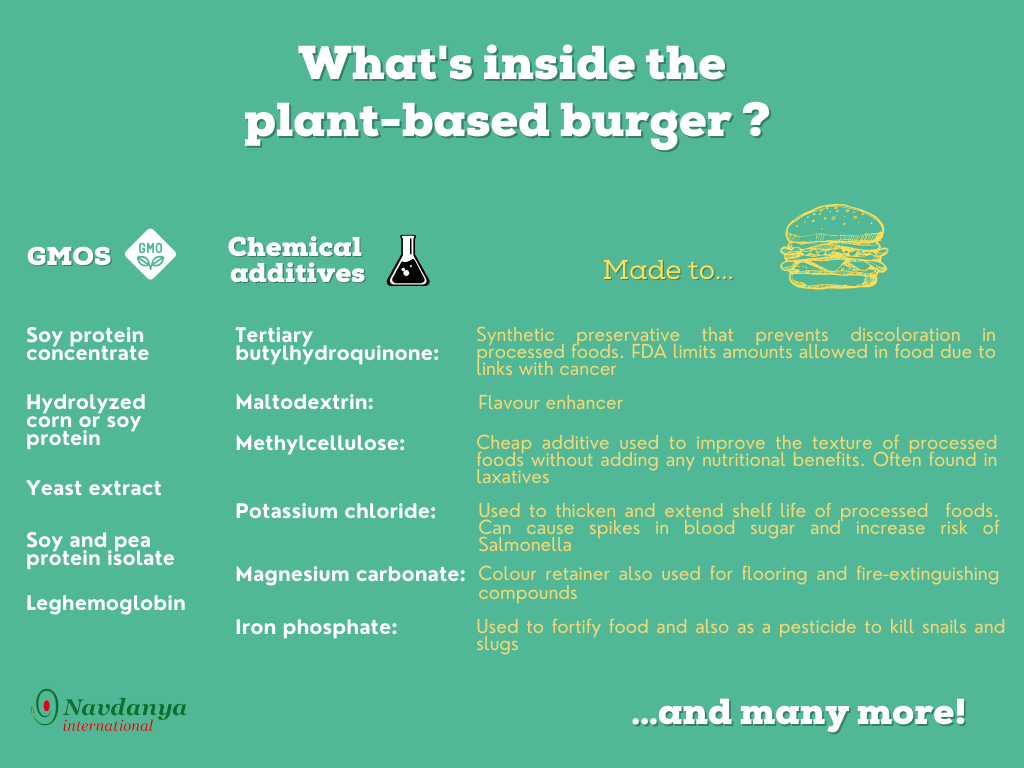
The safety of new ingredients and additives used is also a cause for concern. For example, to make the Impossible Burger appear to “bleed” like real meat, a synthetically produced “heme” molecule is added which comes from soy leghemoglobin, a colorant produced in genetically engineered yeast. The adoption of this patented new ingredient has been nothing short of controversial. According to the Center for Food Safety, the FDA did not conduct adequate long-term testing before approving the additive in 2019, and after a short-term rat trial, several potential adverse effects were detected like changes in weight gain, changes in the blood that can indicate inflammation or kidney disease, disruptions in the reproductive cycle and possible signs of anemia. Despite the lack of evidence that the additive is safe, Impossible Foods’ products containing genetically engineered heme are now being sold in supermarkets across the United States, exemplifying the lack of testing and regulation for these new products and technologies.
Highly toxic glyphosate has also been found in the Impossible Burger with amounts being more than enough to have a variety of negative health effects.This is also not mentioning synergistic effects this might have with the variety of toxic food additives these companies mix in to mask flavors, and the unknown health effects of synbio-produced additives.
Profitable Patents
Synthetic foods symbolize yet another profit-making machine used by billionaires and big corporations to capitalize on proprietary technology and increase their control over the world’s resources. This is reflected in companies’ ceaseless pursuit of patents for anything from novel processes of synthetic biology, genetically engineered ingredients like soy leghemoglobin, protein texturizing processing and even the patenting of genetic materials used as raw materials. As was shown in the Navdanya International Gates to a Global Empire report, 27 patents have been assigned to Impossible Foods, with over 100 additional patents pending for other fake meat proxies, from chicken to fish.
The patenting logic that underlies the synthetic food movement, sees animals and nature as disposable elements that can simply be replaced by more efficient technologies such as lab-engineered products. This dangerous way of thinking reduces animals to mere inputs in a production system, thus completely ignoring our relationship with nature and further creating a rift separating humans from nature and food from life.
Handing over control of our food to a handful of multinational companies does not only make us increasingly dependent on them, it can also have detrimental consequences on local food systems and erode the food sovereignty of organic farmers.
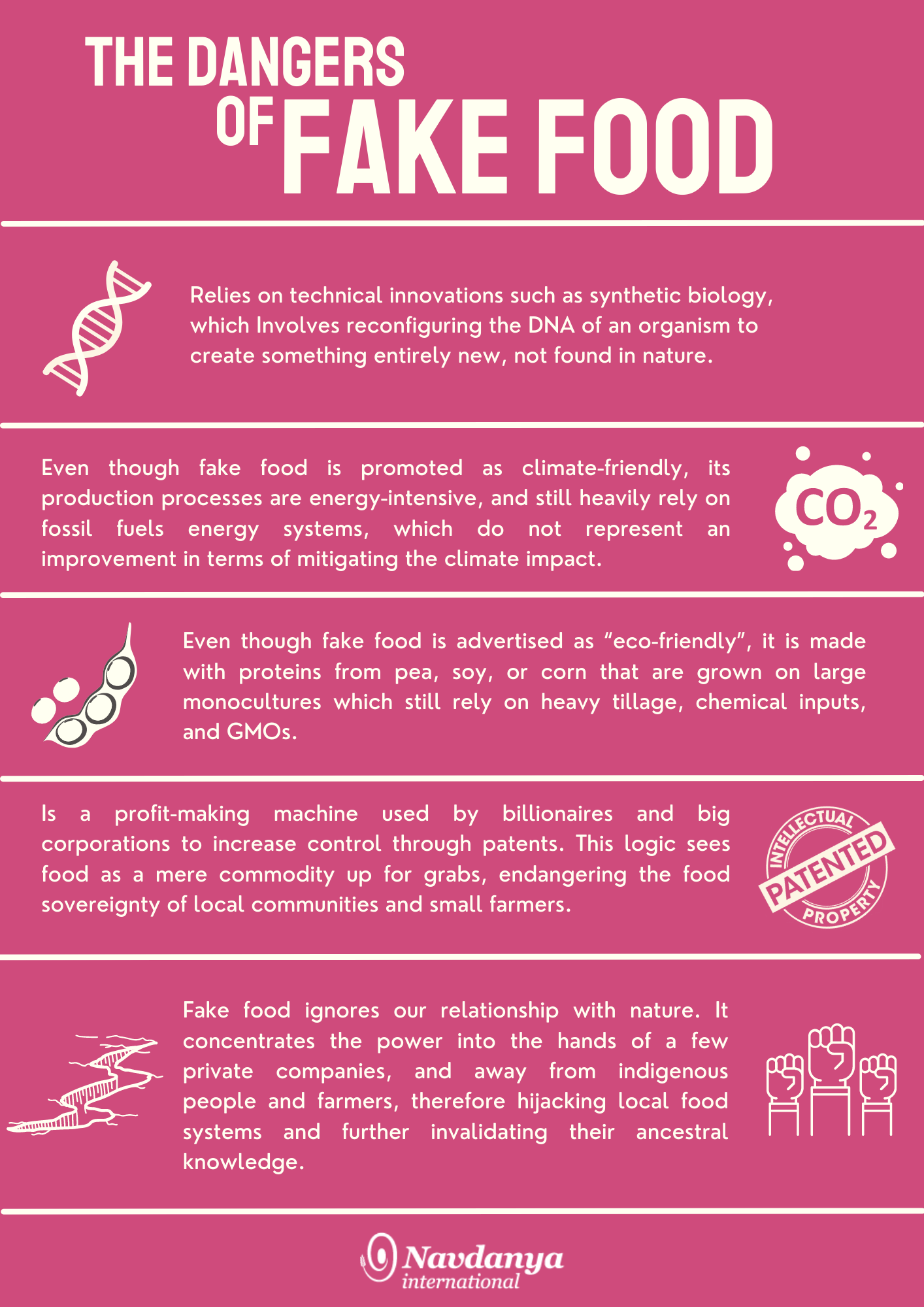
International appetites for ultra-processed foods
In addition to conquering our plates and diets, synthetic food is slowly starting to take over multi-level governance arenas. This was most apparent in last years’ UN Food Systems Summit, as well as the COP26. Both serving as forums to showcase the true intentions of agribusiness and food giants– namely, to keep the system unchanged. As anticipated, both summits marked yet another failed attempt at addressing power imbalances in the food system, with sustainable farming practices like agroecology only playing a marginal role. The summits were thus met with resounding backlash from environmental associations and civil society organizations.
Reflected in the themes and proposals of both international events was the willingness to keep business as usual and continuing to rely on the failed industrial agricultural model by allowing big actors to dictate terms. For instance, during both the UNFSS and the COP26 there was explicit promotion of artificial and ultra processed plant-based foods, under the language of achieving ‘protein diversification’ and ‘sustainable diets’. During the COP26 the “Plant-Based Treaty” was promoted and backed by all the above-mentioned actors, and during the UNFSS under similar initiatives were promoted in Action Track 2 led by Nestlé, Danone and the controversial EAT organization.
Which future for our food?
There are many dangers associated with the above discourses entering the global governance arena. Especially if they mean a further consolidation of policies that shift attention and resources away from organic farmers and local markets toward a handful of biotech companies. Despite food advocates’ claims that the proliferation of synthetic alternatives to animal products can resolve animal welfare concerns and solve many of our ongoing crises, the ‘plant-based’ label means very little if it is based on industrial models, monocultures, GMOs, pesticides, and other destructive agricultural practices that lead to biodiversity loss, ecological degradation and worsening health.
Synthetic food is thus nothing more than a fake solution that aims to replace products without challenging the power structures that underlie the corporate agricultural model. Moreover, it completely ignores the solutions offered by the growing regenerative agriculture movement and completely disregards the role of small producers and food communities in shaping our food systems. This mindset explains why we will soon see Beyond Meat burgers in McDonald’s plant-based menus when we should instead focus on the necessity for real regenerative agriculture and systemic change to protect nature and people’s health.
What We Need is Real Food
In the end, these artificial, synthetic foods dismantle our connection with nature and in doing so, they completely disregard the role of natural processes and the laws of ecology that are at the heart of real food production. By promoting the illusion that we live outside of nature’s ecological processes, this new technology will only serve to increase corporate control over food and health, accelerate the collapse of local food economies and further destroy food democracy. The real solution to the environmental, and health crises should be based on an active rejuvenation and regeneration of the planet by working with ecological processes through agroecological and regenerative farming practices.
Contrary to the claims of the agro-industry and food tech companies, food cannot be reduced to a commodity to be put together mechanically and artificially in labs and factories. Food is the currency of life and it holds the contribution of all beings involved at all stages of production. Claiming otherwise would be a negation of local indigenous knowledge and pastoralist cultures that have evolved alongside diverse ecosystems over the centuries to regenerate biodiversity and contribute to the diversity of farming systems.
Animals, humans, and nature have always lived in interconnected, symbiotic relationships which in turn regenerate all systems that support life. This synergy is vital to the renewal of soil fertility, the creation of habitat for biodiversity, and the rejuvenation of Earth’s water, carbon, and nutrient cycles. While concerns about the meat industry are legitimate, animals integrated into a biodiverse, agroecological system can provide a viable alternative to an agricultural system based on exploitation and environmental destruction. Animals have always held a central function in agroecological systems, since when they feed on grass, pests, and weeds, they, in turn, fertilize the soil, improve biodiversity at all levels, and help sequester carbon back into the earth. Animals in symbiotic and balanced relationships with plants, soils, and humans have also formed central parts of cultural and agricultural reproduction for millennia, contributing to much more than just meat production.
On the other hand, the industrial raising of animals through CAFOs (Concentrated Animal Farm Operations) who are force-fed industrially grown grains and soy, contribute to the expansion of GHG-emitting industrial agriculture, causing a greater release of methane and the pollution of air and water sources. It is important to emphasize how these two systems are not at all alike, as meat consumption per se is not the problem, rather it is the industrial meat production model hand in hand with the industrial agriculture model that is responsible for the majority of GHG emissions, animal suffering, and environmental degradation. Therefore, the real solution does not lie in creating substitutes for food, it lies in understanding the needs of the ecosystems we are embedded in and healing our connection with nature.
Real food made through real farming is the direct result of a process of care for the land, animals, and fellow humans that celebrates the connection between food and life. It protects the life of all beings on Earth while also nourishing our health and wellbeing. Artificial food is a direct manifestation of years of food imperialism and colonization that has denied our diverse food knowledge, food cultures, and disregarded the biodiversity of the earth and its ecosystems.
Hope does not lie in pursuing technological innovations such as lab-grown synthetic foods that see nature as a dead and unimprovable technology, but in participating and rejuvenating the earth’s natural processes. The question of what we eat, how we grow the food we eat, and how we distribute it has become a survival imperative for the human species and all beings that make up the web of life. When we farm with real knowledge of how to care for the Earth and her biodiversity, when we eat real food which nourishes the biodiversity of the Earth, our cultures, and our gut microbiome, we are then participating in real and living economies that regenerate the well-being of all. All over the world, small farmers and gardeners are already preserving and developing their soils and their seeds through the practice of agroecology. They are feeding their communities with healthy and nutritious food while also rejuvenating the planet.
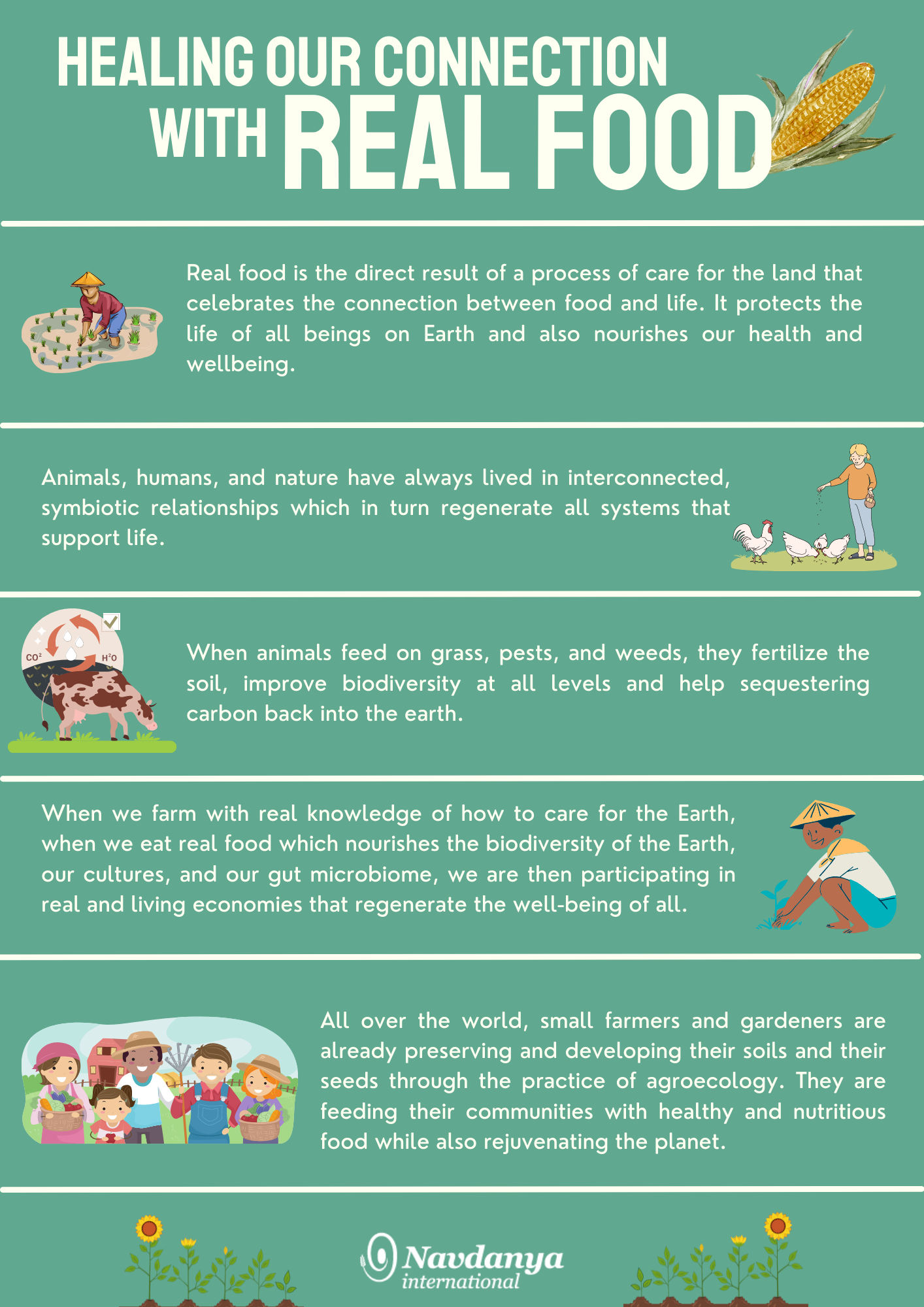
[1] Kyriakopoulou, Konstantina, et al. “Plant-Based Meat Analogues.” Sustainable Meat Production and Processing, edited by Charis Galanakis, Academic Press, 2019, pp. 103–126. Science Direct. doi.org/10.1016/B978-0-12-814874-7.00006-7.
An Impossible Menu: Fake Food Is Taking Over Our Tables
 A plate of fortified Golden Rice as the first course, a second course of Impossible Burger, and a side dish of synthetic mozzarella with vegetables grown from genetically modified seeds. Of course, selling such a menu doesn’t really seem easy. However, if it were made clear that such a menu is necessary to protect the environment and that it is also beneficial to our health, then perhaps more people would be willing to indulge. Perhaps there would even be more governments willing to fund private research in this artificial nutrition. There is no doubt that a menu conceived in a laboratory, yet at the same time ecological, represents a captivating narrative. But is this a realistic representation, or are we faced with yet another greenwashing operation to hide the usual interests behind a fluorescent green veneer?
A plate of fortified Golden Rice as the first course, a second course of Impossible Burger, and a side dish of synthetic mozzarella with vegetables grown from genetically modified seeds. Of course, selling such a menu doesn’t really seem easy. However, if it were made clear that such a menu is necessary to protect the environment and that it is also beneficial to our health, then perhaps more people would be willing to indulge. Perhaps there would even be more governments willing to fund private research in this artificial nutrition. There is no doubt that a menu conceived in a laboratory, yet at the same time ecological, represents a captivating narrative. But is this a realistic representation, or are we faced with yet another greenwashing operation to hide the usual interests behind a fluorescent green veneer?
One thing can be said with certainty: the development of the artificial food industry as the best response to environmental challenges is a biased one. The global food industry is in fact trying to reshape its range of products to appeal to an increasingly green consumer base, and it is aware of the fact that many of these consumers are not well-informed about the causes of the current environmental disasters. Disasters that can be largely blamed on the same circle of businessmen, who today finance the development of the biotech industry. Far from wanting to admit its mistakes and contribute to a process of regeneration, it seems that Big Food has found a way to impose yet another set of technological solutions to a series of problems triggered by the very model of industrial agribusiness on which it is based. This represents a billion-dollar business operation.
But even assuming that we have already reached the point where we have no other option than to rely on artificial food, and for this we will forced to pay the multinationals a lot of money, another objection remains unresolved: many of the foods synthesised in laboratories are based on raw materials derived from an industrial agricultural process dependent on intensive monocultures, often derived from GMO seeds and with a high chemical input. In other words, the questionably laudable attempt to save the planet from the negative impact of animal farming rests on the same production system that is destroying wildlife, polluting water and soil, and warming the planet. A vicious cycle that would seem to make little sense if one did not consider the actors behind such proposals. And yet, despite the many contradictions, synthetic food appears to be a surmountable challenge for the industry that has decided to heavily invest in this sector. It is therefore no coincidence that artificial food was high on the agenda at the recent UN Food Systems Summit in New York.
An ecological choice?
Let’s start with the most important question. Is artificial food a real solution to climate change and environmental degradation in general? Certainly, producing food in a laboratory does not involve the direct large-scale exploitation of natural resources such as water and soil. Yet many studies are questioning the alleged sustainability of this industry, which now comprises a constellation of start-ups capable of proposing increasingly ingenious technological solutions. Many companies are investing in cellular meat, also known as cultured meat, made from real animal cells. This same technology is also aiming to revolutionise the dairy sector with so-called cultured milk.
 The Canadian company Better Milk, for instance, is investing heavily in the production of cow’s milk using bovine mammary cells. There are now also start-ups who have already thought of applying the same logic to humans. TurtleTree Labs, a start-up based in Singapore and the US, is poised to launch human lactoferrin into the market, as the first commercial cellular product for newborns. US-based Biomilq has also announced that it is ready to market the first synthetic baby milk cultured from human cells. Is this product comparable to breast milk? The company doesn’t claim their product is identical to breast milk, but “it will be free from the environmental toxins, food allergens, and prescription medications that are often detected in breast milk”, because “it is produced outside the body in a controlled, sterile environment free Indeed, this is a well-founded argument, as the latest studies on natural breast milk show. A recent American intercollegiate study found the presence of PFAS in 100% of the breast milk analysed: all 50 samples examined showed the presence of the dangerous chemical substances at levels up to 2,000 times higher than those considered safe in drinking water. Yet, in spite of this, the feeling remains that the industrial apparatus systematically aims to invest in technological solutions in order to profit from the problems it has itself created. This is a perverse logic that allows for the ceaseless pollution of the environment in order to sell artificial solutions.
The Canadian company Better Milk, for instance, is investing heavily in the production of cow’s milk using bovine mammary cells. There are now also start-ups who have already thought of applying the same logic to humans. TurtleTree Labs, a start-up based in Singapore and the US, is poised to launch human lactoferrin into the market, as the first commercial cellular product for newborns. US-based Biomilq has also announced that it is ready to market the first synthetic baby milk cultured from human cells. Is this product comparable to breast milk? The company doesn’t claim their product is identical to breast milk, but “it will be free from the environmental toxins, food allergens, and prescription medications that are often detected in breast milk”, because “it is produced outside the body in a controlled, sterile environment free Indeed, this is a well-founded argument, as the latest studies on natural breast milk show. A recent American intercollegiate study found the presence of PFAS in 100% of the breast milk analysed: all 50 samples examined showed the presence of the dangerous chemical substances at levels up to 2,000 times higher than those considered safe in drinking water. Yet, in spite of this, the feeling remains that the industrial apparatus systematically aims to invest in technological solutions in order to profit from the problems it has itself created. This is a perverse logic that allows for the ceaseless pollution of the environment in order to sell artificial solutions.
Similarly, artificial ‘plant-based’ foods are also based on technical innovations such as synthetic biology, which involves reconfiguring an organism’s DNA to create something completely new, that cannot be found in nature. Companies such as Beyond Meat and Impossible Foods use a DNA coding sequence derived from soybeans or peas to create a product that looks and tastes like real meat. The famous Impossible Burger is made almost entirely from common crops: wheat, maize, soya, coconut and potato. But one key ingredient, heme, the molecule that gives meat its flavour, is not so easy to obtain from natural sources, and this is why it’s synthesised in the lab.
As Pat Brown, founder and CEO of Impossible Foods, declares: “We use genetically engineered yeast [obtained from soy DNA] to produce heme, the “magic” molecule that makes meat taste like meat — and makes the Impossible Burger the only plant-based product to deliver the delicious explosion of flavour and aroma that meat-eating consumers crave.”
Artificial meat is also made up of protein and fat from peas, potatoes, soya, and maize grown in monocultures based on the same heavy processing methods, chemical inputs and GMOs that are compromising global biodiversity, destroying wildlife, altering soils and polluting groundwater sources. Yet, the first point in the marketing campaigns of synthetic food companies remains invariably that of reduced environmental impact. This assumption is difficult to prove, considering that plant-based synthetic foods are based on the exact same system as industrial agriculture. It is therefore no surprise that a recent study by the Health Research Institute Laboratories found levels of glyphosate (and its metabolite Ampa) in the Impossible Burger to be 11.3 ppb. This is more than enough to have a negative impact on our intestinal microbiota and therefore on our immune system. Not to mention the “probable” carcinogenicity of glyphosate declared by the IARC and its now proven ability to act as an endocrine disruptor.
The sustainability of the biotech production system compared to the traditional one has been questioned by numerous studies also from the point of view of GHG emissions linked to climate change. According to recent research, carbon dioxide emissions resulting from the industrial processing of synthetic meat may persist in the atmosphere for hundreds of years, unlike methane produced by traditional intensive livestock farming, which dissolves in the atmosphere after about ten years. As a matter of fact, a large amount of energy is required for the production process, involving several energy-intensive steps, including the operation of the bioreactors, temperature controls, aeration and mixing processes. Given these indicators, the food tech industry is not in a position to boast about the superior ecological performance of fake foods as opposed to that of traditional production systems. Only a total de-carbonisation of energy systems could improve this indicator, therefore, synthetic food does not seem to have a legitimate place in the category of “eco-friendly” food, but rather in the category of ultra-processed food, due to the high-impact transformation process required.
In contrast with traditional plant-based foods these new meat alternatives should be considered ultra processed foods, which nutritionists generally recommend avoiding due to their harmful health effects. A recent study analyses these new synthetic foods from a nutritional point of view, looking at each individual ingredient. Ultra processed foods often contain high levels of sodium and fats in order to be appealing to the palate, and synthetic meat is no exception, since it exceeds the sodium content of natural meat. The ingredients that make up cultured meat are ultra-refined and, like other ultra processed foods, need to be generally supplemented with nutrients and fortifiers. Many of the nutrients found in natural meat, such as iron, zinc and Vitamin B-12, are added as separate ingredients in synthetic meat. However, these nutrients cannot be absorbed as effectively from fortified foods, as they can be from whole foods such as meat, nuts and seeds.
As a consequence our bodies may also obtain less health benefits from them. The researchers thus conclude that a healthy and environmentally friendly diet does not require new technologies and should not include more industrial products that have been heavily processed. Instead, it should be based on organic and regenerative agriculture which offers healthier products with richer nutrients.
Big food: artificial food, natural profit
In light of the above, we cannot claim that artificial food is good for the environment and the health of consumers. What can be said, however, is that it is undoubtedly lining investors’ pockets. Biotech companies and agribusiness giants are building up to invade one of the most promising markets of the near future: that of “green” consumption. The result is a whole range of artificial foods such as meat, eggs, cheese and dairy products synthesised in laboratories.
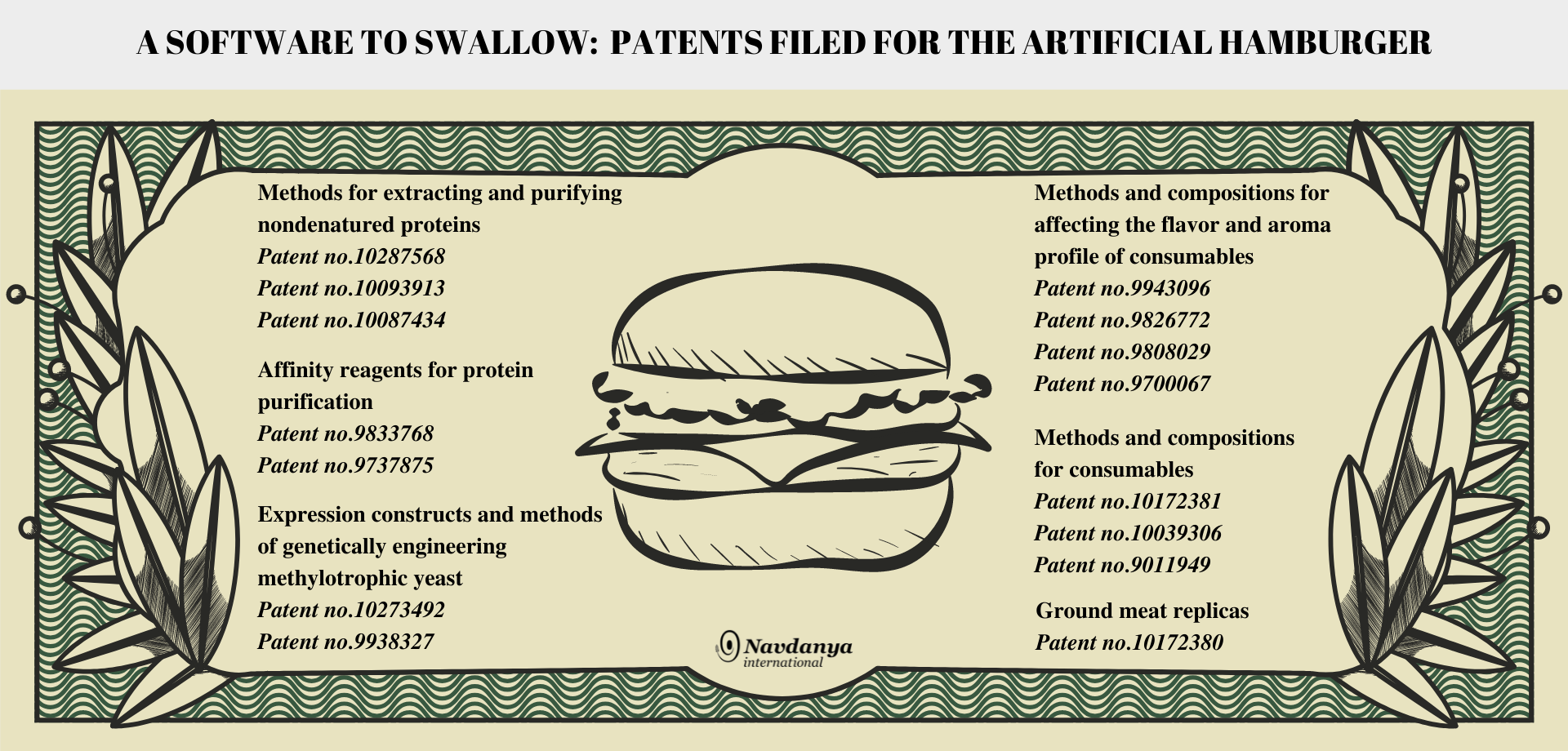
The system is always the same. Especially in terms of patents. For the Impossible Burger alone, at least 14 patents have been filed and hundreds more are waiting to be approved for other synthetic edible products and ingredients. This is an era-defining change of perspective. Firstly, due to the logic of patents, animals and plant products continue to be treated as disposable items that can be simply replaced by more efficient technologies such as laboratory products. Humans’ profound relationship with nature is completely ignored. It is again the CEO of Impossible Foods who explains this relationship well, for those who have not yet understood it: “Animals,” says Pat Brown, “have just been the technology we have used up until now to produce meat…What consumers value about meat has nothing to do with how it’s made. They just live with the fact that it’s made from animals.”
Secondly, because we continue to lose control over the origin and production of our food, we are gradually giving up our food sovereignty. Artificial food does not present itself as a clear alternative for our diet but, by disguising itself as a form of traditional food, it tries to sneak its way onto our tables. It is a full-fledged counterfeiting operation that aims to gain control over our diet by making food evermore dependent on the multinational companies that produce and patent it. However, continuing to hand over control of our food to a few companies can have detrimental impacts on local food systems by eroding people’s food sovereignty. According to biotech companies, nature and its living organisms are nothing more than an exhausted, obsolete technology: “If there’s one thing that we know,” the Impossible Foods CEO argues, “it’s that when an ancient, unimprovable technology counters a better technology, that is continuously improvable, it’s just a matter of time before the game is over.”
Pat Brown, on the other hand, also seems on his game “when he says that his investors “clearly see ‘a $3 trillion opportunity’ emerging on the horizon. The numbers prove him right. The synthetic biology industry is booming. It has reached a value of $12 billion in the last decade and is expected to double by 2025, to reach $85 billion in 2030. This exponential growth is confirmed by the latest Synbiobeta figures: the first quarter of 2021 saw record investments in start-ups of $4.7 billion and $4.2 billion in the second quarter. In the last twenty years, the number of companies specialising in this field has risen from less than 100 in 2000 to more than 600 in 2019. Beyond Meat has been one of the “hottest” stocks in 2019. The plant-based meat company’s shares grew a whooping 859% during its first three months.
It is no coincidence that, alongside industrial giants such as Cargill and Tyson Foods, even the biggest ‘environmental’ philanthropists are investing in this sector. Bill Gates, for example, has invested in Impossible Foods, Beyond Meat, Memphis Meats (now Upside Foods), Motif and Hampton Creek Foods and Biomilq. A path followed by Richard Branson and Jeff Bezos, founders of Virgin and Amazon respectively. There are even some investments for products made in Italy.
A German start-up company, Formo, has just received record funding from its shareholders of $50 million to develop large-scale production of ricotta and mozzarella in the laboratory. The funding represents a record for a European foodtech start-up and sends a clear signal to investors and markets around the world.
Fortified and ultra-processed food
The recent Food Systems Summit in New York, held last September amid protests from international environmental associations, is perhaps the place and time where the intentions of the food multinationals found their best expression. In pages and pages of documents, mentions of organic or agroecology can be counted on one hand and, even when they are mentioned, they seem to play a mere sideline function. The development model must remain the same, namely that of the failed but profitable Green Revolution. The actors involved, i.e. the big investors and the agribusiness multinationals, must also remain the same in order to continue to profit from the new technological investments. What they believe needs to be radically changed is, quite simply, the narrative. This is the only truly green element to be found in the action plans of the masters of food. Yet, it cannot be said that we had not been warned. After all, Action Track 1 and 2 of the Summit lay out the global strategy very thoroughly.
Action Track 1, ‘Ensure access to safe and nutritious food for all’, promotes large-scale food fortification as a solution to malnutrition. Food fortification is the process of supplementing food with additional nutrients. This process may also involve the use of biotechnology and genetic modification. It is an approach often recommended, and put into practice, in developing countries where nutritional deficiencies are found. Expanding and enriching the diet, to ensure access to healthy food for the population, could solve many problems. However, multinational companies think it is cheaper to market only one fortified food.
A classic example is Golden Rice, a rice genetically modified to contain levels of beta-carotene that can remedy vitamin A deficiencies in the population. The Bill and Melinda Gates Foundation has so far given $28 million to fund Golden Rice. The project is in direct collaboration with the Global Alliance for Improved Nutrition (Gain, founded in 2001 by Bill Gates). Gain, leader of Action Track 1, was among the first organisations to use the public-private partnership model. Since then, it has continued to support biofortification projects to combat malnutrition and food insecurity. Gain also shares many of the same donors as AGRA (Alliance for a Green Revolution in Africa), such as the Rockefeller Foundation, BSF or Unilever, and received no less than $251 million from the Bill and Melinda Gates Foundation between 2002 and 2014.
The approach based on fortifying one single food rather than increasing the diversity and quality of foods available has, according to many observers, undermined the ability of communities to strengthen local food systems that are based on cultural and traditional knowledge, thereby destroying their food sovereignty. Policies pushing for biofortification, like other technological solutions, are accused of inducing dependence on a handful of staple crops or single added ingredients, thus ignoring the central role of biodiversity in nutrition. Simply adding one nutrient does not seem to be able to solve the problem of malnutrition, but it does seem to produce excellent profit margins for the agribusiness multinationals.
One of the countries most involved in food fortification programmes is Bangladesh. A recent analysis by activist Farida Akhter captures the contradictions of an approach that continues to develop along the corroded tracks of the green revolution: “Monoculture rice crops, using almost 80 percent of the land, are resulting in a deficiency in the production of other essential food crops needed for nutritional balance. Poor dietary diversity, with 70 percent of the diet comprising cereals and inadequate protein and micronutrient intake is blamed but it is not mentioned how the monoculture production and use of pesticides affect the availability and quality of food and nutrition. Instead of transforming the chemical-based agriculture, new techn-fixing of few food items, edible oil fortified with vitamin A, rice fortified with zinc, salt fortified with iodine are offered as solutions to malnutrition. These are not the only foods that people eat. An agroecological and biodiversity-based approach to farming for food production would solve most of the problem”.
Many other examples of public-private partnerships to genetically modify (or biofortify) crops exist. For example, sorghum through the Africa Biofortified Sorghum Project, and cassava by the BioCassava Plus project in partnership with the National Root Crops Research Institute in Nigeria. Both projects aim to improve nutrition security and correct vitamin deficiencies in Africa by fortifying staple crops and supplementing them with beta carotene, which the body then converts to vitamin A, Iron and protein. The list also includes the controversial GMO banana, created by Dr. James Dale at Queensland University of Technology, which has received over 15 million in funding from the Gates Foundation and is now being pushed in India and Uganda. While the imposition of this iron-enriched GM crop claims to save women’s lives by remedying iron deficiencies in anemic women and preventing death during childbirth, it may instead contribute to the erosion of biodiversity in India, which has always had a high diversity of bananas, as well as other iron rich foods.
Moreover, GMOs are also starting to be falsely equated to biofortification in order to greenwash them further and allow them to sneak their way into our foods. This became apparent at a Codex Alimentarius Meeting held in Germany where despite opposition from a majority of the countries present, there was a clear push for including GMOs in the biofortification definition. Needless to say, such a controversial decision would promote market deception and illustrates a lack of transparency in establishing food standards and guidelines. If the pro-GMO forces are able to continue hiding their genetically modified foods within the definition of biofortification, consumers will be deceived on a worldwide scale and deliberately left confused about whether they are buying organic products or something else entirely.

Action Track 2 of the Summit, “Shifting to Sustainable and Healthy Consumption Patterns”, is also based on solutions whose sustainability is highly questionable. The action plan is essentially based on the promotion of artificial and ultra-processed plant-based foods with the aim of achieving “protein diversification”. This approach leaves many doubts because, just as in the case of food fortification, simply adding isolated proteins, vitamins and minerals to diets does not seem to have the same health benefits as fresh, whole foods. The excessive processing of products has in many cases led to strong controversy about the many chemical substances used, so that many of these foods fall firmly into the category of ‘junk food’.
Interestingly, leading Action Track 2 of the Summit is EAT, an organisation linked to the World Economic Forum, with partners such as Nestlé and Danone, both leaders in the production of ultra-processed foods. The recommendations of the action plan come directly from the EAT-Lancet report “Food in the Anthropocene: the EAT-Lancet Commission on healthy diets from sustainable food systems”. This is a highly controversial report because, while on the one hand it calls for sustainability and the transformation of food systems through the promotion of ‘healthy diets’, on the other hand it glosses over the direct role of industrial and chemical agriculture in creating unsustainable and unhealthy food systems. The report never comes close to considering that the adoption of healthy diets may depend on a departure from the industrial agriculture paradigm and the adoption of agroecological practices. Instead, it promotes the notion of ‘sustainable intensification’ of current food systems with a shift in the global consumption axis towards ‘plant-based’ alternatives. A solution that, once again, threatens to replace biodiverse and local diets with ultra-processed synthetic foods produced with patented technologies that are highly profitable only and exclusively for the agribusiness multinationals.
EAT has a partnership through FrESH with the junk food industry, and Big Ag such as Bayer, BASF, Cargill, Pepsico amongst others.
Which future for our diets and the planet?
It is clear that it would be difficult to sit down in a restaurant today and confidently order an entire menu of artificial food. Yet, in the near future, this choice might not seem so bold. In fact, it might even sound like a responsible one. In an even more distant future, this may no longer be a choice, but instead the only option for not getting up from the table hungry. In this future, which is perhaps closer than we think, there may be fewer choices than we have today. If agroecology and organic production are not adequately supported, that future, which seems dystopian to us today, may actually come true due to a lack of alternatives.
Some might object: but aren’t the EU’s Farm to Fork and Biodiversity strategies asking us, among other things, to expand the area under organic production by 25% and cut pesticide use by 50% by 2030? The answer lies in the implementation of these strategies, which should primarily take place through a reform of the CAP, the EU’s agricultural policy which, when allocating resources, prefers to subsidise large-scale conventional producers. Finally, it should not be forgotten that the Farm to Fork strategy itself nods to the new technologies of genetic manipulation, which includes the new generation of GMOs. This is yet another gift to the big multinationals in the sector who, through their pervasive and costly lobbying campaigns, always manage to land on their feet. All this considering that the EU’s policies remain, by far, the most progressive globally.
If this is the larger scenario in global politics, what happens at the individual level? Consumer choices have a major impact on markets, as demonstrated by the growth of organic worldwide. According to IFOAM, 2020 showed the highest growth of the global market for organic products, growing to 120 billion euros. Consumers instinctively mistrust synthetic food and this is perhaps why there is a need to accompany these products with an ecological narrative. But this narrative struggles to stand on its own. While vegetarian and vegan diets have the potential to have a positive impact on the environment, artificial meat, egg and cheese substitutes may not. On the contrary, there is much to suggest that the biotech industry is not as sustainable as it claims to be, regardless of their promising and vast greenwashing campaigns aimed to capture a growing number of consumers who genuinely want to make greener food choices. This is the same group of consumers who, if not misled by the industry’s greenwashed narrative, would most likely opt for an organic diet, thus favouring market growth and therefore the overall food supply. From this point of view, large investments in the biotech and synthetic food industries could further delay those regenerative and truly sustainable processes that are trying to emerge, regardless of the great difficulty, at a local level all over the world.
________________________________________________
Source: An Impossible Menu: Fake Food is Taking Over Our Tables, Manlio Masucci, Terra Nuova magazine, February 2022
 Navdanya and the Navdanya movement were created by Dr. Vandana Shiva 30 years ago in India to defend Seed and Food sovereignty and small farmers around the world. Navdanya pioneered the movement of seed saving and seed freedom, which began in response to the crisis of erosion of agricultural biodiversity and introduction of GMOs and patents on seeds through intellectual property rights (IPRs) and so-called ‘free trade’ agreements. It has long fought against biopiracy, the patenting of indigenous knowledge by self-interested multinational corporations and won cases related to Neem, basmati rice and wheat in India. Navdanya promotes a new agricultural and economic paradigm, a culture of food for health, where ecological responsibility and economic justice replace the present greed, consumerism and competition which have become dominant in society. It aims at regaining the common good as a foundation for a renewed sense of community, solidarity and culture of peace. We strive to achieve these goals through the conservation, renewal and rejuvenation of the gifts of biodiversity we have received from nature and our ancestors, and to defend these gifts as commons. More…
Navdanya and the Navdanya movement were created by Dr. Vandana Shiva 30 years ago in India to defend Seed and Food sovereignty and small farmers around the world. Navdanya pioneered the movement of seed saving and seed freedom, which began in response to the crisis of erosion of agricultural biodiversity and introduction of GMOs and patents on seeds through intellectual property rights (IPRs) and so-called ‘free trade’ agreements. It has long fought against biopiracy, the patenting of indigenous knowledge by self-interested multinational corporations and won cases related to Neem, basmati rice and wheat in India. Navdanya promotes a new agricultural and economic paradigm, a culture of food for health, where ecological responsibility and economic justice replace the present greed, consumerism and competition which have become dominant in society. It aims at regaining the common good as a foundation for a renewed sense of community, solidarity and culture of peace. We strive to achieve these goals through the conservation, renewal and rejuvenation of the gifts of biodiversity we have received from nature and our ancestors, and to defend these gifts as commons. More…
Go to Original – navdanyainternational.org
Tags: Agriculture, Artificial food, Big Food, Capitalism, Corporate Empires, Corruption, Elites, Finance, Greed, Health, Hunger, Inequality, Lab Meat, Organic Agriculture, Post-capitalism, Profits, Public Health, Right to Food, Super rich, Synthetic food, Vandana Shiva, World Order
DISCLAIMER: The statements, views and opinions expressed in pieces republished here are solely those of the authors and do not necessarily represent those of TMS. In accordance with title 17 U.S.C. section 107, this material is distributed without profit to those who have expressed a prior interest in receiving the included information for research and educational purposes. TMS has no affiliation whatsoever with the originator of this article nor is TMS endorsed or sponsored by the originator. “GO TO ORIGINAL” links are provided as a convenience to our readers and allow for verification of authenticity. However, as originating pages are often updated by their originating host sites, the versions posted may not match the versions our readers view when clicking the “GO TO ORIGINAL” links. This site contains copyrighted material the use of which has not always been specifically authorized by the copyright owner. We are making such material available in our efforts to advance understanding of environmental, political, human rights, economic, democracy, scientific, and social justice issues, etc. We believe this constitutes a ‘fair use’ of any such copyrighted material as provided for in section 107 of the US Copyright Law. In accordance with Title 17 U.S.C. Section 107, the material on this site is distributed without profit to those who have expressed a prior interest in receiving the included information for research and educational purposes. For more information go to: http://www.law.cornell.edu/uscode/17/107.shtml. If you wish to use copyrighted material from this site for purposes of your own that go beyond ‘fair use’, you must obtain permission from the copyright owner.
Read more
Click here to go to the current weekly digest or pick another article:
FEATURED RESEARCH PAPER:

